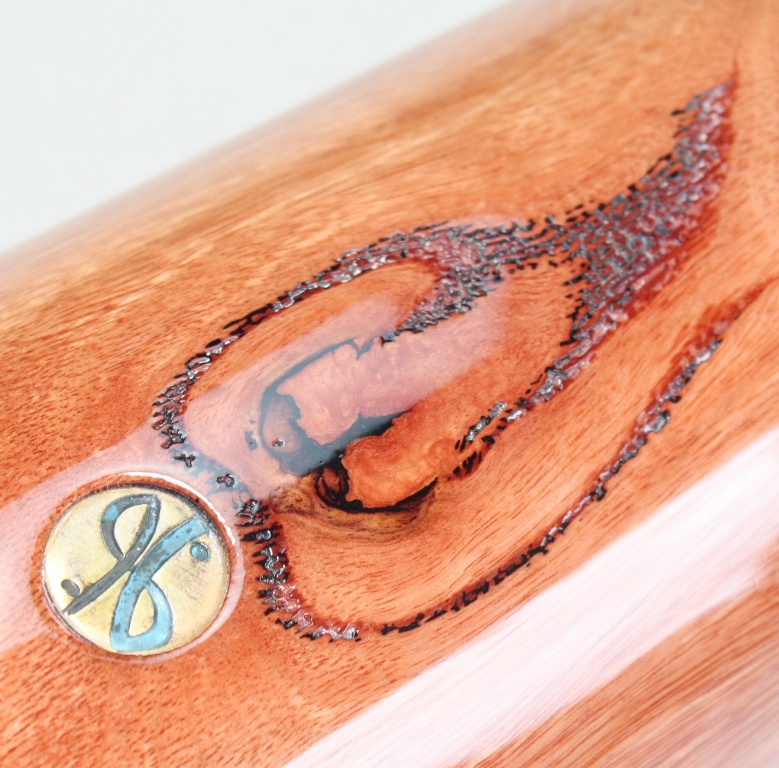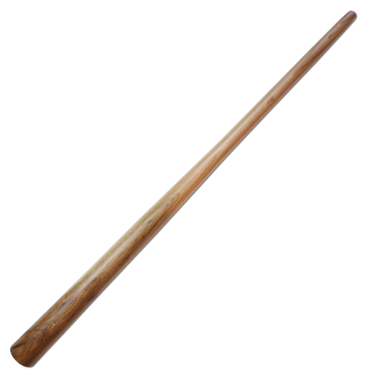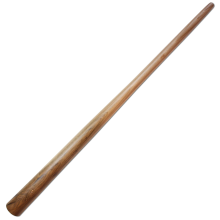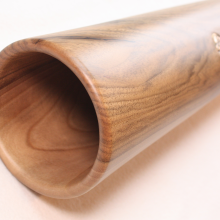Duende Magius C
Produit plus disponibleComments from Dubravko Lapaine: Magius is our new didgeridoo model that we offer in tones from A1 to D2. This is a very high-end didgeridoo that offers an unprecedented level of playing comfort combined with supreme sound and tuning.
But it was not an easy and direct path to get there. Let me explain. When we created Sumo it brought many new aspects of sound and playing to our style of didgeridoo and it was very different from anything else we have created. The biggest difference was those air pulses for the percussion sounds which were such full, perfect bubbles. Soft but firm. All this was supported by excellent counter pressure.
The next stage of thinking was to create an instrument that would be strong in the two aspects that Sumo is not and which are very important to me. One is the precision of the game, the ability to articulate well at higher speeds and the other would be the toots. If you have experience designing didgeridoo, you may know that it is difficult to improve good didges. In other words, it's hard to turn something into a great design so you don't lose more than you gain. But this time, the magic worked. Magius is indeed a didgeridoo greatly improved in terms of toots and articulation while retaining much of the incredible playing comfort of the Sumo. In a way, you could think of Magius as 70% Sumo + 30% Spirit (or 75/25 in previous models), although this is just an image to help you understand, not a the exact reality. We take our didgeridoo design very seriously and we are very picky about what we make into models.
Magius was therefore tested and perfected for more than two years before this version. What you can expect is an incredibly versatile didgeridoo, falling somewhat in the middle of all didgeridoo playing techniques. If we're talking numbers again, I'd say Magius is 60% push, 40% pull (or 55/45), which is an incredible position. Don't get into that "jack of all trades, master of none" mindset, because the way Magius sits comfortably on his throne of balance is nothing short of magical. Don't expect it to be ideal for traditional play and don't think it will overpower the spirit and you will have an incredible delight in what didgeridoo magic really is and the goodness it can bring to your game.
My comments: I am incredibly lucky to be able to present such an instrument to you. It is made in one piece, pierced on both sides. The instrument is a true sculpture, both visual and sonic. I don't have enough rating stars to add more because this instrument is so wonderful. I now understand why the Dubravko gold class is sold at this price... quite simply because this instrument is much more than a didgeridoo, it is above all a professional quality musical instrument!
- Duende Magius: Gold class (master) in Walnut / water-based PU impregnated epoxy finish
- Shipping costs are free! (only for France)
- Didgeridoo Passion also offers you the carrying case
Are you going to tell me it's a bit expensive for a Didgeridoo?
Didgeridoo Passion selects high-end instruments for you for extraordinary sound and playability! It is an investment that must be made by all those who want to access the high end in terms of sound, design and handling. Sound quality is in symbiosis with a perfect body!
Classification
This scale is the result of an air column/bell start ratio If we divide the diameter of the bell with that of the beginning of the air column we get a number between 1.5 and 3.5. We can classify all the didgeridoos in 4 large families. Each family groups the instruments with a similar character, simply based on the overall shape of the air column (conical/cylindrical) and on the diameter of the column (wide/narrow). The result is a simple and very reliable reading grid, making it easier to search and purchase on line.
The diameters are measured with a caliper, start of the air column after the mouthpîece. This ratio is very reliable for a didg having a air column with a 'smooth' internal work, in the case of a hollowed eucalyptus instrument it give an approach of the instrumental character.

Duende
Dubravko Lapaine & Danka Tišljar, Manufacturers of "Duende" didgeridoos
Here's something I've never done until now, but to open the subject: For comparison, we can compare the world of didgeridoo manufacturers to the world of automobiles. By this I mean that in the case of a car, we find all kinds of brands, finishes, power for ultimately the same goal of transporting us from point A to point B. However, you are all d I agree that comfort is not the same in a two-horse car or in a Ferrari... Well the didgeridoo is the same thing, the purpose is the same: to be able to transcribe a vibration. To date, after 20 years of playing, hundreds of didgeridoos tested and meeting many manufacturers, I can give you my perspective. If I had to place one type of didgeridoo in place of the Ferrari it would be the Duende didgeridoos by Dubravko Lapaine. To fully understand the characteristics of a didgeridoo and therefore be a good maker, you must first of all be a good player.
 You see what I mean. Dubravko is recognized as the best technician in the world. he has such high standards for himself that it shows in his production. Why do I think Duendes are the best didgeridoos you can find? It can't be summed up in a single sentence, but it starts with the drilling manufacturing process that Dubravko has mastered to perfection. No cutting or gluing for ultimately better control of dimensions. Imagine drilling straight over a length of more than 2 m... This continues with the type of wood used. This time again Dubravko leaves nothing to chance, he uses the densest wood species we can find. This aims to contain vibration as much as possible and provide a wealth of harmonics and exceptional playability. But this has a downside... the sharpening of the tools which you have to do constantly and therefore an enormous amount of work time... We continue with the internal configurations of the air columns. Again Dubrako has developed these own configurations over the years and his concerts. Because above all he makes his own instruments seeking a compromise between the finesse of sounds and technicality. In the execution of all game techniques and sounds.
You see what I mean. Dubravko is recognized as the best technician in the world. he has such high standards for himself that it shows in his production. Why do I think Duendes are the best didgeridoos you can find? It can't be summed up in a single sentence, but it starts with the drilling manufacturing process that Dubravko has mastered to perfection. No cutting or gluing for ultimately better control of dimensions. Imagine drilling straight over a length of more than 2 m... This continues with the type of wood used. This time again Dubravko leaves nothing to chance, he uses the densest wood species we can find. This aims to contain vibration as much as possible and provide a wealth of harmonics and exceptional playability. But this has a downside... the sharpening of the tools which you have to do constantly and therefore an enormous amount of work time... We continue with the internal configurations of the air columns. Again Dubrako has developed these own configurations over the years and his concerts. Because above all he makes his own instruments seeking a compromise between the finesse of sounds and technicality. In the execution of all game techniques and sounds.
We now move on to finishing the instruments, both inside and out. Because a beautiful paint job on a car immediately has an effect, the same goes for the didgeridoo. By this I mean that each Duende is truly unique. These are real collector's items. If you have ever held a Duende in your hands you will understand what I am telling you. Inlay, engraving, pyrography and so on, all these techniques add enormous added value and bring the instrument to life. I hope that through these words you will understand the value of Duende didgeridoos. So yes the Duendes are not cheap but I think that after what I have just written it allows you to understand the extreme value of its instruments. Just like a Ferrari, it is a treasure that we offer ourselves for the ultimate passion. Unique know-how, for a unique design, playability and finish!



